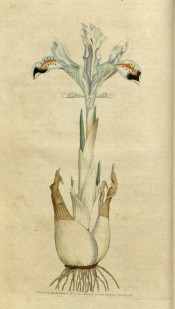Iris persica L.
Fully-hardy, bulbous, dwarf iris with linear leaves and stems with 1-4 silvery-grey to sand-yellow or pale green, scented flowers in late winter and spring. To 10cm. [RHSE, Hortus, Lynch].
Horticultural & Botanical History
‘Its beauty, early appearance, and fragrant blossoms, make it highly esteemed by all lovers of flowers; like the hyacinth and Narcissus it will blow within doors in a water-glass, but stronger in a small pot of sand, or sandy loam; a few flowers will scent a whole apartment: it will also bloom in the open air but requires warmth and shelter. […] Parkinson remarks, that in his time it was very rare, and seldom bore flowers.’ [BM t.1/1786].
‘Among the many old plants that have most injudiciously been disregarded by modern cultivators, the Persian Iris occupies a conspicuous place. Its merits, indeed, are of so rare an order, that it is really wonderful that so few gardens contain it.’ [MB p.77/1843].
‘This beautiful species has been in cultivation in England for three centuries, for it was accurately described by Parkinson in 1629.’ [Dykes]. FS f.1045/1856.
History at Camden Park
Listed in all published catalogues [B.249/1843].
Notes
Published Nov 04, 2009 - 05:17 PM | Last updated Jul 23, 2010 - 05:21 PM
| Family | Iridaceae |
|---|---|
| Category | |
| Region of origin | Middle East |
| Synonyms |
|
| Common Name | Persian Iris |
| Name in the Camden Park Record | Iris Persica |
| Confidence level | high |
